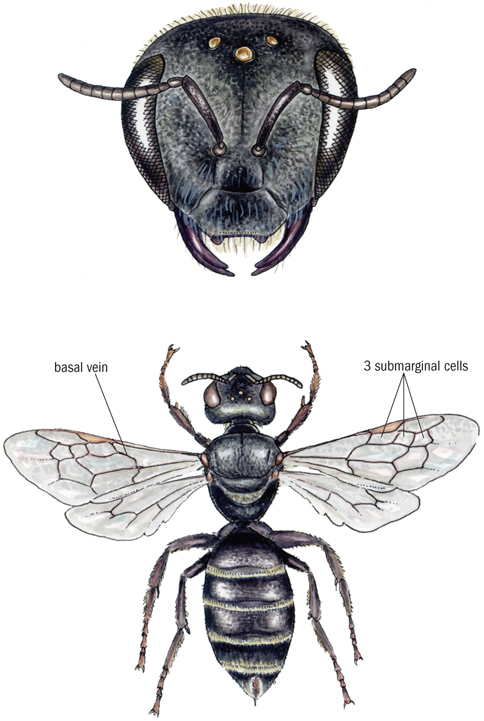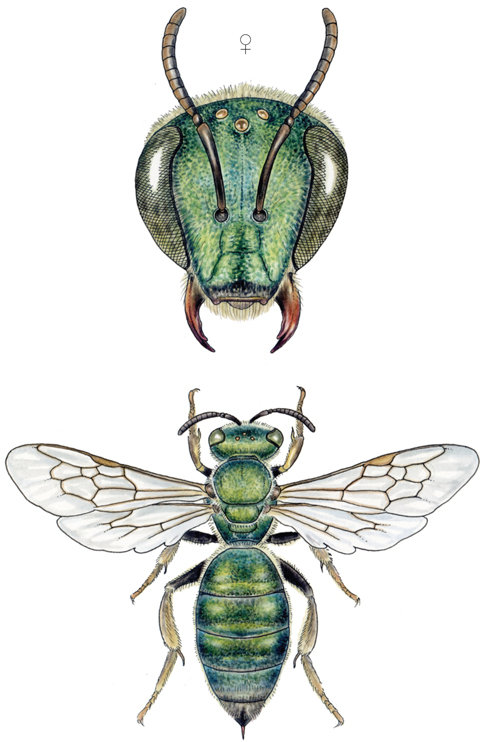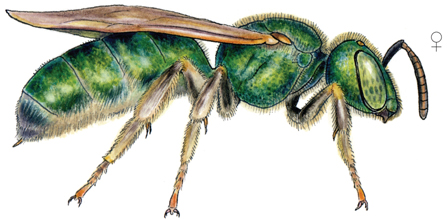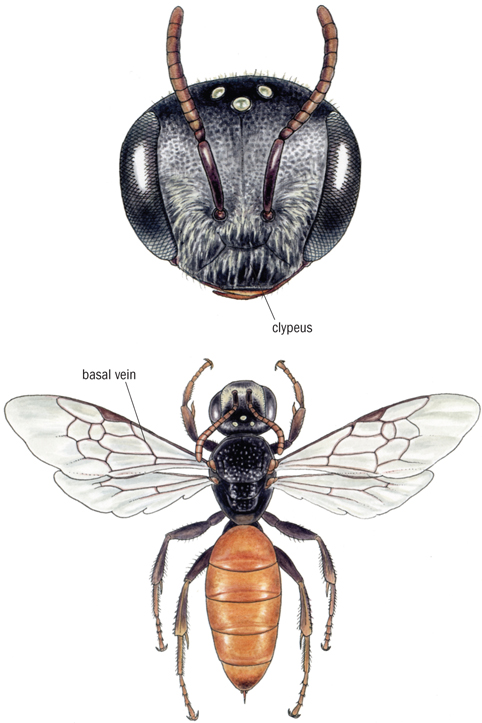SWEAT BEES (Family Halictidae)
Family Halictidae is found worldwide. Most members of the family are of small to medium size 0.1–0.6 in. (4–14 mm) and are generally dark colored, though a few are bright green and some are red. Several species have yellow markings, particularly in the males, who often have yellow facial markings. Members of the family Halictidae are morphologically very similar. They have even been called boring because they look so much alike. Even so, they have an amazing diversity of social behaviors, with some species having queen and worker castes (though not as complex as those in the Western Honey Bees). Some species are social under certain conditions and solitary under others. The family is most easily distinguished under magnification. One characteristic that would suggest you are observing a member of this family is the presence of an arch toward the base of the basal vein on the fore wing. Some members of Halictidae forage in the evening and into the night, which is unusual for bees.
There are 34 genera in the family Halictidae in North America: Several genera within this family are commonly observed in California: Halictus and Lasioglossum (both referred to as sweat bees), the metallic green Agapostemon, the ground-nesting Dufourea, and the Sphecodes, or cuckoo bees.
SWEAT BEES, Genus Halictus
Common California species: Halictus tripartitus NATIVE
H. ligatus NATIVE

Halictus tripartitus, native

Halictus ligatus, native

Halictus ligatus, native (profile)
GENUS SUMMARY: Halictus (hah-LICK-tuss) is a widespread and abundant genus that occurs in both the New World and Old World. There are about 200 identified species worldwide and 25 species in North and South America, and seven species are known from California. Each of the species found in California is broadly distributed across the western United States—and in some cases, Mexico and Canada. Halictus and the closely related genera Lasioglossum and Agapostemon are all called sweat bees because they are attracted to human sweat and drink it for its salt content.
There is one species in California, Halictus harmonius, which is listed on the Xerces Society’s Red List of endangered insects. This species is found in the San Bernardino and San Jacinto Mountains.
DESCRIPTION: Halictus are small to medium-size bees, 0.2–0.6 in. (4.5–14 mm) long. They are dark brown to black and many species have a dark metallic green sheen. They have bands of hair on the outermost edge of the tergites on their abdomen. Females carry pollen on brushes of hair (scopae) on their hind legs. Halictus have three submarginal cells in their fore wing. Under magnification, you can see they have a distinctive wing characteristic, the basal vein strongly arched at the base of the vein; if you look at the submarginal cells of the fore wing, all the cross veins are equally strong, which means you can see both edges of the veins. This is different from what you find in Lasioglossum, where the cross veins are weak and look like a single line.
SIMILAR INSECTS: Lasioglossum are similar to Halictus but can be distinguished by the location of hair bands on the segments of their abdomen and the thickness of the cross veins of the submarginal cells as I mentioned above. Halictus has bands of hair on the outer edge of each segment, whereas Lasioglossum has bands of hair on the inner edge of each segment.
FOOD RESOURCES: Most Halictus are generalist foragers. They use a number of genera of plants, from the Asteraceae to Scrophulariaceae. They are very common on composites (daisy-like disc and ray flowers) in summer and fall.
NESTS: Almost all Halictus in North America are semi-social ground nesters. Daughters in social colonies remain in the nest and help care for the young. Nests vary across species from small nests with a single queen and a few workers to nests with multiple queens and hundreds of workers.
FLIGHT SEASON: Individual species can often be seen from spring to early fall. This is due in part to their semisociality. A single nest can be established in spring and continue to reproduce through to fall.
GREEN SWEAT BEES, Genus Agapostemon
Common California species: Agapostemon texanus NATIVE

Agapostemon texanus (female), native

Agapostemon texanus (female), native (profile)

Agapostemon texanus (male), native
GENUS SUMMARY: The genus Agapostemon (ag-uh-PAHST-eh-mon) is widespread and abundant throughout North America, with approximately 40 species in total and five species in California. There are approximately 44 identified species worldwide. They are most diverse and abundant in temperate regions and southwestern US deserts. Agapostemon are commonly called sweat bees because they are closely related to, and resemble, bees in the Halictus and Lasioglossum genera. Unlike those bees, however, Agapostemon are not attracted to human sweat.
DESCRIPTION: Agapostemon are brightly colored metallic green or blue bees. They are medium-size, 0.3–0.6 in. (7–14.5 mm) long. Females of most species in California have a bright metallic green head and thorax and abdomen; some have a black-and-yellow striped abdomen. Females carry pollen on scopal hairs located on their hind legs. Female Agapostemon are relatively fast-flying bees. Males generally have a green head and thorax and a black-and-yellow striped abdomen, and they fly much more slowly because they are often searching flowers for females. Under magnification, you would look for a shield-like indentation on the abdomen to confirm that a large bright green bee is an Agapostemon, and the face of the propodeum or the back of the thorax is completely encircled by a clearly raised line.
SIMILAR INSECTS: Osmia species can also be metallic green but are more robust and carry pollen on the underside of the abdomen instead of on the hind legs. Augochlora species do not have a raised line on their thorax. Some cuckoo wasps also look similar to Agapostemon.
FOOD RESOURCES: Agapostemon are generalists. Like other members of the family Halictidae, they are short tongued and thus have difficulty extracting nectar from deep flowers. Males can be observed flying slowly around flowers looking for females.
NESTS: Agapostemon dig deep vertical burrows in flat or sloping soil, or sometimes in banks. Most species are solitary, but some species nest communally. Up to two dozen females may share a single nest entrance, but each individual builds and provisions its own cluster of brood cells. Where a communal nest gallery shares a single entrance, one bee usually guards the hole, with only her head visible from aboveground.
FLIGHT SEASON: These are summer to fall bees.
SWEAT BEES, Genus Lasioglossum
Common California species: Lasioglossum titusi NATIVE

Lasioglossum titusi, native

Lasioglossum titusi, native
GENUS SUMMARY: Lasioglossum (laz-e-o-GLOSS-um) is a very large genus that occurs worldwide. There are approximately 280 species in North America and approximately 87 species in California. They are often the most common bees in a habitat but are frequently overlooked because of their small size. Lasioglossum are closely related to the genera Halictus and Agapostemon. These genera are commonly called sweat bees because they are known to be attracted to human sweat, which they drink for its salt content.
DESCRIPTION: Lasioglossum are slender, dusky black to brown, dull green, or blue bees, with bands of hair on their abdomen. They are tiny to medium-size bees, 0.1–0.4 in. (3–10 mm) long. Females carry dry pollen on scopae (brushes of hair) on their hind legs. Under magnification, you can see that in the fore wing the basal vein is strongly arched at the base of the vein and that the submarginal cells are weak, which means they look like a single line rather than a double line.
SIMILAR INSECTS: Lasioglossum are similar to Halictus but can be distinguished by the location of hair bands on their abdomen. Lasioglossum have bands of hair on the innermost portion of each segment, whereas Halictus has bands of hair on the outermost portion of each segment. The wing veins in Lasioglossum are also not as thick as those on Halictus.
FOOD RESOURCES: Lasioglossum are a mix of specialist and generalist foragers. Specialists are known to be attracted to Oenothera. At least one species that is a generalist has a strong preference for Clarkia. Some are cleptoparasites.
NESTS: Lasioglossum includes species that exhibit the full range of bee social behaviors, including solitary, communal, and social habits. Most species nest in the ground. In social colonies, daughters remain in the nest and help care for the young. Some of the social species have small nests with a single queen and a few workers, whereas others build long-lived nests with multiple queens and hundreds of workers. Some Lasioglossum have glands that produce a mix of chemicals called lactones. Each individual bee has its own unique combination of lactones and lines the nest entrance, burrow, and cells. This helps a worker recognize her own nest when she returns from foraging.
FLIGHT SEASON: These bees are seen from early spring to summer. Some species persist into fall.
SWEAT BEES, Genus Dufourea
Common California species: Dufourea vernalis NATIVE

Dufourea vernalis, native
GENUS SUMMARY: Dufourea (dew-FOUR-ea) is a Holarctic genus that is found all across North America. There are approximately 170 identified species worldwide, approximately 80 species known from North America, and 57 in California. Most species are found only in the western United States, and many are unique to California.
DESCRIPTION: Dufourea are small to medium-size, 0.1–0.4 in. (3.5–11 mm) long, narrow-bodied bees. They are usually black, dull green, or metallic blue, and sometimes they have a red abdomen. They may have slight bands of pale hair on their abdomen. The antennae on this genus are positioned very low on the head—below the midpoint of the eyes. Under magnification, you can see the clypeus is usually short and wide, and the labrum is nearly as long as the clypeus. They have two submarginal cells. These bees are diverse morphologically. In particular, they have a lot of variation in their mouthparts. These bees are usually specialists, and the variability in their mouthparts is probably related to the different host plants that each species uses.
SIMILAR INSECTS: Dufourea looks like many other Halictidae, particularly members of the genus Lasioglossum. The antennae of Dufourea are much lower on the head than on Lasioglossum.
FOOD RESOURCES: Most of the species in this genus are specialist bees. They specialize on a wide variety of different plants, including Linanthus, Eschscholzia, Clarkia, Oenothera, Helianthus, Campanula, Calochortus, Monarda, Phacelia, Cryptantha, Mimulus, Cactaceae, and various others.
NESTS: These are ground-nesting bees. They appear to have fairly shallow nests. These bees are parasitized by another species of bees, and you can sometimes see several parasites hovering above a nest entrance waiting to sneak in and lay an egg in the wall of a cell while it is being provisioned.
FLIGHT SEASON: These bees are found from spring to fall.
CUCKOO BEES, Genus Sphecodes
Common California species: Sphecodes NATIVE

Sphecodes unidentified species, native

Sphecodes unidentified species, native (profile)
GENUS SUMMARY: Sphecodes (sfe-KO-deze) is a large cleptoparasitic genus found on all continents and is widespread throughout its range. There are about 300 identified species worldwide, 80 species in North America, and it has been estimated there are about 60 species in California, many unidentified and without names. These bees are not very well known and are not well represented in museum collections, so these are only estimates of the numbers of species. Sphecodes are cleptoparasites; that is, they invade the nests and lay their eggs in the cells of other species. Their offspring then kill the host larvae and take over the provisions of the host bees. Members of the genus Sphecodes primarily lay their eggs in the nests of Halictus and Lasioglossum species. These cleptoparasites are commonly referred to as cuckoo bees because their behavior mimics that of cuckoo birds.
DESCRIPTION: These are shiny brown to black slender bees with few hairs. They often have red on all or part of the abdomen. They are minute to moderate in size, 0.2–0.6 in. (4.5–15 mm) long. Under magnification, you can see that the basal vein of the fore wing is strongly arched at the base of the vein and all the veins are equally strong. Like all other cleptoparasites, Sphecodes lack pollen-collecting hairs because they visit flowers only to drink nectar, not to collect pollen. With a microscope, you can see the relatively large depressions (punctuation) in the exoskeleton. Females have spines on their hind legs that they use to brace themselves in the tunnel of a nest when being attacked by a host bee. They also have lots of ridges and lamellae in their exoskeleton that help deflect the sting and mandibles of an angry host.
Many of the bees in this genus are unnamed or undescribed. What this means is that they have been discovered but have not yet been formally described and named in the scientific literature. Until a formal description is published, a species is considered to be undescribed and unnamed.
SIMILAR INSECTS: Sphecodes can resemble wasps. Males of Sphecodes look similar to Lasioglossum males but have a shorter face and antennae and an entirely black clypeus. They have no hair bands on the terga, unlike Halictus.
FOOD RESOURCES: Sphecodes do not make their own nests, so they do not forage for pollen for their offspring. They will visit a variety of flowers for nectar.
NESTS: The entire genus Sphecodes is cleptoparasitic on many other genera of bees. Cleptoparasites do not construct their own nests. They instead lay their eggs in the nests of other bees, entering a nest while the host female is away gathering pollen. When their larvae hatch, they kill the host bee’s larvae or eggs and eat their provisions.
FLIGHT SEASON: These are late spring to early fall bees. There are some early spring records for Southern California.